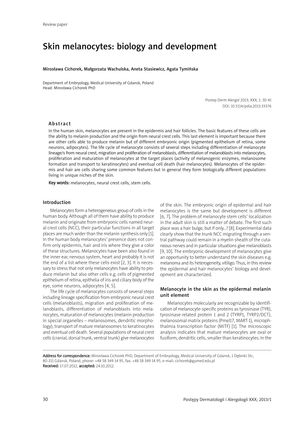Skin Melanocytes: Biology and Development
January 2013
in “
Postepy Dermatologii I Alergologii
”
melanocytes neural crest cells epidermal melanocytes hair follicle melanocytes anagen phase melanosome keratinocytes dermal fibroblasts melanoma vitiligo melanosome development tyrosinase melanogenesis growth factors signaling pathways melanocyte stem cells skin pigment cells hair growth phase skin cells skin connective tissue cells skin cancer skin depigmentation pigment production cell communication proteins

TLDR The paper concludes that understanding melanocyte development can help in insights into skin diseases and melanoma diversity.
The 2013 review paper discussed the biology and development of skin melanocytes, which are pigment-producing cells originating from neural crest cells. It covered their life cycle, including differentiation, migration, proliferation, maturation, and cell death. The paper highlighted the distinct biological differences between epidermal and hair follicle melanocytes, with the latter being more sensitive to aging and active only during the anagen phase of the hair growth cycle. It also described the molecular markers of melanocytes, melanosome transfer to keratinocytes, and the influence of keratinocytes and dermal fibroblasts on melanocyte biology. The review aimed to provide insights into skin diseases like melanoma and vitiligo by understanding melanocyte development, including the stages of melanosome development, the role of tyrosinase in melanogenesis, and the influence of various growth factors and signaling pathways on melanocyte development from neural crest cells. It also touched upon the embryonic origin of melanocytes and the potential locations of melanocyte stem cells in adults. Understanding the origins and development of melanocytes may offer insights into the heterogeneity of melanoma.










